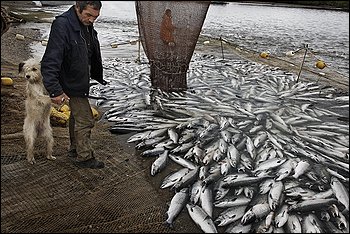
© Randy Olson/National Geographic Stock
Global fisheries have expanded so rapidly over the past half-century that the world is running out of places to catch wild fish, according to a
new study conducted by researchers in Canada, the United States and Australia.
The findings, published Thursday evening in the online journal
PLoS ONE, are the first to examine how marine fisheries have expanded geographically over time. Looking at fleets' movements between 1950 and 2005, the five researchers charted how fishing has been expanding southward into less exploited seas at roughly one degree latitude each year in order to compensate for the fact that humans have depleted fish stocks closer to their shores in the Northern Hemisphere.
During that same period the world's fish catch increased fivefold from 19 million metric tons in 1950 to a peak of 90 million in the late 1980s, before declining to 87 million tons in 2005. It was 79.5 million tons in 2008, according to the U.N. Food and Agriculture Organization, the most recent year for which figures are available.
Daniel Pauly, a co-author who serves as principal investigator of the Sea Around Us Project at the University of British Columbia Fisheries Centre, said the global seafood catch is now dropping "because there's essentially nowhere to go." The fact that fish catches rose for so many decades "looks like sustainability but it is actually expansion driven. That is frightening, because the accounting is coming now."
The authors - including lead author and UBC doctoral student Wilf Swartz and National Geographic Society ocean fellow Enric Sala - write that this relentless pursuit for seafood has left "only unproductive waters of high seas, and relatively inaccessible waters in the Arctic and Antarctic as the last remaining 'frontiers.' "
"The focus should move from looking for something new to looking at what we have and making the most sustainable use out of it," Swartz said in an interview.
Although the new analysis largely confirms what researchers, activists and policymakers know, the way it quantifies this global trend could provide new ammunition to those who are seeking to curb fishing of some of the world's most imperiled species. Last week, for example, negotiators at the International Commission for the Conservation of Atlantic Tunas - which oversees dozens of fish stocks in the Atlantic Ocean - imposed new restrictions on vulnerable species such as oceanic whitetip and hammerhead sharks but stopped short of making deep cuts in the annual catch of imperiled bluefin tuna in either the eastern or western Atlantic.
"People are beginning to look at science and understand if we don't start managing these fisheries properly we're going to be in trouble, not only because of ecological reasons, but because they're important sources of food and income," said Russell Smith, National OAA's assistant secretary for international fisheries.
But some of the nations that have traditionally sought out the most seafood, or depend on it as a primary food resource, are resisting steep cuts in fishing quotas. A spokesman for the Japanese Fisheries Agency's international affairs division said when the issue of these restrictions come up, "We look at actual situations of each kind of marine resources, and those that need protection we will protect, and with those species that are scientifically proved to not need over-protection, we will act accordingly. We look at scientific facts" to determine that.
National Fisheries Institute spokesman Gavin Gibbons, whose group is the largest seafood trade organization in the U.S., said the global depletion of wild fisheries helps explain why farmed fish now accounts for roughly half of the world's seafood production. But he noted that it is still important to make distinctions between fish stocks: his group backs a ban on taking bluefin tuna from the Mediterranean, but does not support environmental groups' call for a moratorium on fishing in the bluefin tuna's Gulf of Mexico spawning grounds.
"There's no need to stop commercial fishing in all oceans," Gibbons said. "You have to manage what you're doing effectively."
While 80 percent of the bluefin tuna caught in the Atlantic ends up in Japan, it has emerged as a hot-button issue in the U.S. and elsewhere. This week the advocacy group Center for Biological Diversity called on consumers, chefs and restaurateurs to boycott the fish and places that serve it, including D.C.'s Sushi Taro restaurant. Farmers & Fishers restaurant in Georgetown also recently offered bluefin tuna on its menu.
Sushi Taro did not return a call for comment Thursday. A spokesperson for Farmers & Fishers restaurants said that bluefin tuna has not been served in the restaurant since that occasion. Dan Simons, managing partner for the Farmers & Fishers restaurants, said in an earlier statement that "we'll be more diligent to ensure mistakes don't happen with regards to serving sustainable fish to our guests. We have committed to work to serve fish in support of the Ocean Foundation's guidelines, and applaud them on their efforts to help protect our oceans."
"Bluefin tuna are teetering on the brink of extinction," said Catherine Kilduff, one of the group's staff attorneys. "If regulators won't protect these magnificent fish, it's up to consumers and restaurants to eliminate the market demand, and that means refusing to eat, buy or serve this species."
Replacing wild fish altogether would not be easy, Gibbons noted. Ray Hilborn, University of Washington professor of aquatic and fishery sciences, recently estimated that switching from wild fish to an equivalent amount of animal protein from pigs, cattle and chickens could take land resources equal to 22 times the rainforest that currently exists.
fish anyway so...